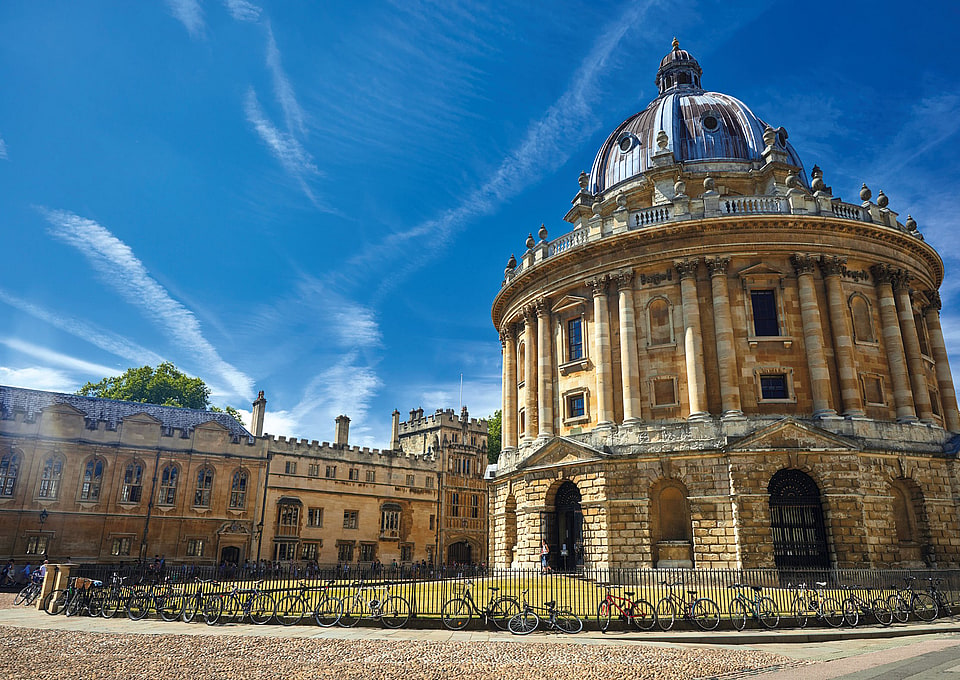17 of the Best Attractions You Must Visit in Oxford

Christ Church, Oxford, seen from the south
Oxford is famed for its architectural beauty.
You should also read…
The legendary ‘ivory towers’ and ‘dreaming spires’ that epitomise this stunning city have often been portrayed in literature and film, and when you attend an Oxford Royale Architecture summer course, you’ll have the privilege of getting to know them for yourself.
In this article, we whet your appetite by introducing you to some of Oxford’s best-loved buildings.
1. Christ Church
Perhaps controversially, this is the only one of the Oxford colleges we’re going to include on this list, because otherwise it will turn into a just another list of Oxford colleges! Virtually all Oxford’s beautiful colleges are renowned for their stunning architecture, but Christ Church – founded in 1524 – is perhaps the most famous owing to its numerous appearances in popular film and television. The sight of ‘Tom Tower’, as its impressive entranceway is known, will be familiar to anyone who has seen the likes of The Golden Compass and Brideshead Revisited on the big screen, while its incredible dining hall has been immortalised as none other than the Hogwarts Great Hall in the much-loved series of Harry Potter films.
While it’s stood in for one of the world’s most famous eating halls, Christ Church – in which the cathedral that makes Oxford a city is located – is also noted for being the alma mater of Charles Lutwidge Dodgson, also known as Lewis Carroll, who penned the childhood favourite Alice in Wonderland.
2. The Radcliffe Camera
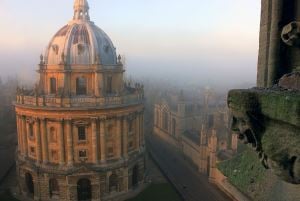
The Radcliffe Camera can only be described as Oxford’s most iconic building. Dominating the small cobbled square in which it’s found, this large, circular building was designed by James Gibbs and built in 1737-1749. Built in the English Palladian style, it forms part of the Bodleian Library complex. It houses mainly English, History and Theology books, and because it’s a working library, only students and scholars are admitted.
3. The Bodleian Library
While the Radcliffe Camera is off-limits to tourists, the nearby Bodleian Library buildings can be seen on one of its guided tours, and there’s an excellent gift shop too. The Bodleian – known colloquially as ‘The Bod’ – is the nerve centre of this vast library, which is a legal deposit library, meaning it’s entitled to a copy of every book ever published in the UK and Ireland. What you see above the ground constitutes only a small fraction of its overall holdings, which are housed in vast underground networks that few will ever be lucky enough to see. As you walk past the main entrance, you’ll see some huge wooden doors, which are adorned by the crests of all the Oxford colleges.
4. The Bridge of Sighs
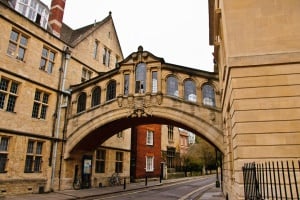
Although it’s not really a building as such, no discussion of Oxford’s architecture would feel complete without some mention of the Bridge of Sighs. Completed in 1914, the Bridge of Sighs lies right opposite the entrance to the Bodleian Library, and connects two part of Hertford College (once the college of Brideshead Revisited author Evelyn Waugh). Famous for its similarity to the Bridge of Sighs in Venice, though not actually modelled on it, this one is a little more ornate and provides a popular photo opportunity for tourists, who pose on New College Lane beneath it.
5. The University Church
The University Church of St Mary the Virgin is flanked on one side by the High Street, and on the other by the cobbled Radcliffe Square. Though the building itself is worth exploring, the view from its lofty heights is the primary basis of its appeal. For a small fee, you can climb to the top of the spire and enjoy a 360 degree view over Oxford’s famous ‘dreaming spires’. There’s also a popular organic cafe, the Vaults and Garden, accessed via Radcliffe Square.
6. The Sheldonian Theatre
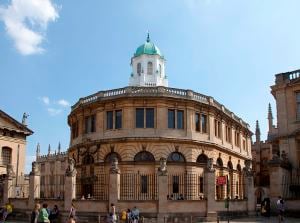
This unusually-shaped building was designed by Sir Christopher Wren, and lies adjacent to the Bodleian Library. The building gets its name from the then-chancellor, the Archbishop of Canterbury Gilbert Sheldon. For most of the year it’s used as a concert venue, and in 2008 it was famously the venue of a speech by the Dalai Lama. However, at the start of the academic year it’s the scene of what’s called the Matriculation Ceremony: the centuries-old process all new Oxford students must go through in order to become an official member of the university. It also marks the end of a student’s academic career, as it’s where graduation ceremonies are held on special days throughout the year. Freshers and graduates have been passing through its doors since it was opened in 1669, making it one of Oxford’s most famous and prestigious venues.
7. The Ashmolean Museum
Famed for being the world’s oldest university museum, the Ashmolean Museum can be found on the corner of Beaumont Street and St Giles, and it’s free to go in. Its imposing Neo-Classical facade, part of the building designed by Charles Cockerell and dating from 1841-45, forms an appropriate entranceway to a collection that houses numerous priceless antiquities and works of art from around the world. Among the treasures you’ll find within are the lantern said to have been used by Guy Fawkes during the Gunpowder Plot, and the Arabic costume of Lawrence of Arabia.
8. The Museum of Natural History/Pitt Rivers Museum
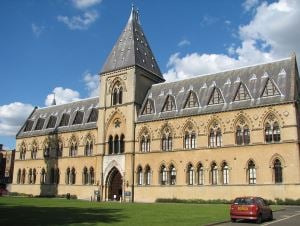
On Parks Road you’ll find Oxford’s Museum of Natural History, Oxford’s answer to London’s more famous Natural History Museum. It’s part of the university and houses a superb collection of zoological and geological specimens, including fossils, stuffed animals, skeletons and geodes. It’s perhaps most famous for its dodo specimen, which comes all the way from the extinct bird’s home, the island of Mauritius in the Indian Ocean. The imposing Gothic-style building housing all this was completed in 1861 by the Irish architects Thomas Newenham Deane and Benjamin Woodward. Newenham Deane’s son was to add the adjoining Pitt Rivers Museum to his father’s work a couple of decades later. The Pitt Rivers Museum is accessed only through the Museum of Natural History, and is noted for its original Victorian cases packed with anthropological curiosities from all over the world – including the revered shrunken heads from South America.
9. The Holywell Music Room
Said to be the oldest purpose-built music room in Europe, the Holywell Music Room was built in 1748 by the Vice-Principal of St Edmund Hall, Dr Thomas Camplin. Situated on Holywell Street, it’s part of nearby Wadham College, and has been the setting for performances from countless famous musical figures, most notably the composer Haydn. There are numerous free concerts held here throughout the year, making it a popular destination with fans of classical music.
10. Blackwell’s Bookshop
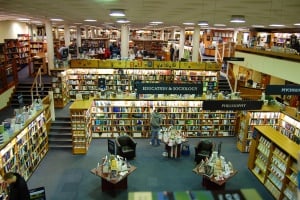
Blackwell’s Bookshop is as much an Oxford institution as some of the revered buildings we’ve already mentioned. The flagship Oxford store – now just one of dozens of branches across the country – began life as a shop measuring just 12ft square. These days it still looks tiny from the outside, but go in via either of its two entrances and you’ll soon discover that it opens out into an Aladdin’s Cave filled to the brim with books on every subject. Since its expansion into neighbouring shops, it’s now spread across several floors, and with a vast basement that goes down several more levels, it’s a building that constantly surprises with nooks and crannies. It’s very easy to get lost in it, and it’s even easier to come out clutching a stack of book purchases bigger than one can realistically carry.
11. Oxford Castle
With most of the focus in Oxford being on the university, it’s easy to forget that its history goes back further than the institution that dominates it. A reminder of this lies in the form of Oxford Castle, a partly-ruined Norman castle dating from the 11th century. It replaces an earlier moated motte and bailey castle on the same site. The castle was mostly destroyed in the English Civil War, and what was left of it became a prison, which occupied these buildings and then a set of new ones built from 1785 onwards. This was in use until 1996, when it was transformed into a luxury hotel.
12. The Examination Schools
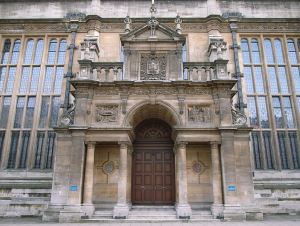
An object of dread for many an Oxford student, the university’s Examination Schools have entrances on both the High Street at the front and cobbled Merton Street to the rear, the latter the scene every year of wildly jubilant celebration by stressed-out Oxford students who’ve just completed a gruelling run of Finals exams. As the name suggests, the Examination Schools are where the university’s formal exams take place, but during term time its purpose-built rooms are also used, in addition to lecture theatres in university departments across the city, for everyday lectures. The building itself was designed by Sir Thomas Jackson and completed in 1882. These days, it’s a focal point for tourists, who aren’t allowed in but come to watch begowned Oxford students going in and out of their exams in May and June.
13. The Turf Tavern
With foundations dating from the 13th century, the famous Turf Tavern is a quaint old pub accessed by a narrow alleyway next to the Bridge of Sighs. Its outdoor seating area is as popular in the winter as it is in the summer, as it has a number of outdoor fires on which punters can toast marshmallows. If you only visit one pub during your time in Oxford, make it this one.
14. Carfax Tower
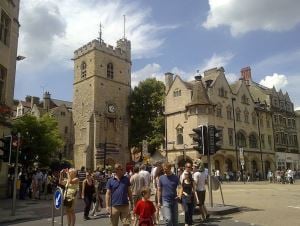
On the crossroads between the High Street, St Aldate’s, Cornmarket Street and Queen Street lies Carfax Tower, right in the heart of the city. In fact, many consider this to be the true centre of the city, and it’s the spot from which distances to other towns and cities are measured. The unusual name derives from the French word ‘carrefour’ – not just the name of the famous French supermarket chain, but the word for ‘crossroads’. It’s noted for its clock, which is a replica of the original church clock of 1676, featuring little figures who chime the bells every quarter of an hour. You can also climb to the top for another great view of Oxford’s dreaming spires.
15. The Grand Cafe
The Grand Cafe on Oxford’s High Street conjures up an atmosphere of old-world opulence. Popular with tourists and students alike, it’s known and loved for its elegant high teas during the day and sumptuous cocktails in the evening. Interestingly, the Grand Cafe was originally the site of England’s first coffeehouse, set up in 1652. Another coffeehouse, the Queen’s Lane Coffee House, lies exactly opposite, and was established just two years later.
16. Saxon Tower
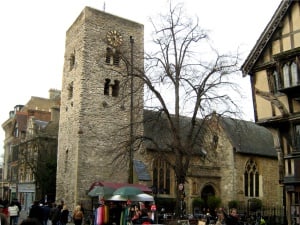
The Saxon Tower of St Michael at the North Gate lies just off busy Cornmarket Street. So-called because this was the site of the northern gate in the days when Oxford had city walls, the church dates to around 1000-1050, while the tower is Oxford’s oldest building, dating from 1040. On display in the church tower is the cell door of the Oxford Martyrs, who were imprisoned in the adjoining Bocardo Prison before being burnt at the stake just outside the city walls, in what is now Broad Street.
17. The Ultimate Picture Palace
Oxford’s first purpose-built cinema was opened in 1911, and retains much of its traditional charm to this day, despite a long period of disuse after its owner was called up for active service during the war. Situated on Jeune Street in Cowley, it still uses old-fashioned raffle ticket-style cinema tickets and you queue up outside to get in. It’s a far cry from the Odeons that dominate the film scene in the city centre, and it’s as nostalgic a cinema experience as anybody could wish for.
We hope you’ve enjoyed this brief introduction to the rich tapestry of Oxford’s historic buildings. There is something of interest everywhere you look in this stunning city, and if you’ve been inspired to visit Oxford, why not join us this summer at our Oxford Summer School.
Image credits: banner; Radcliffe Camera; Bridge of Sighs; Sheldonian, museums; Blackwell’s; Examination Schools; Carfax Tower; Saxon Tower.

